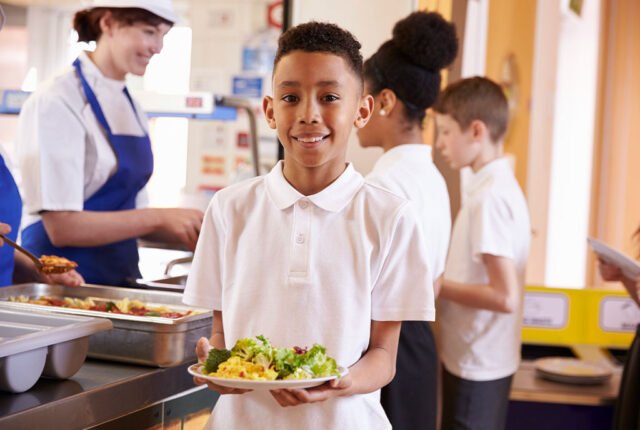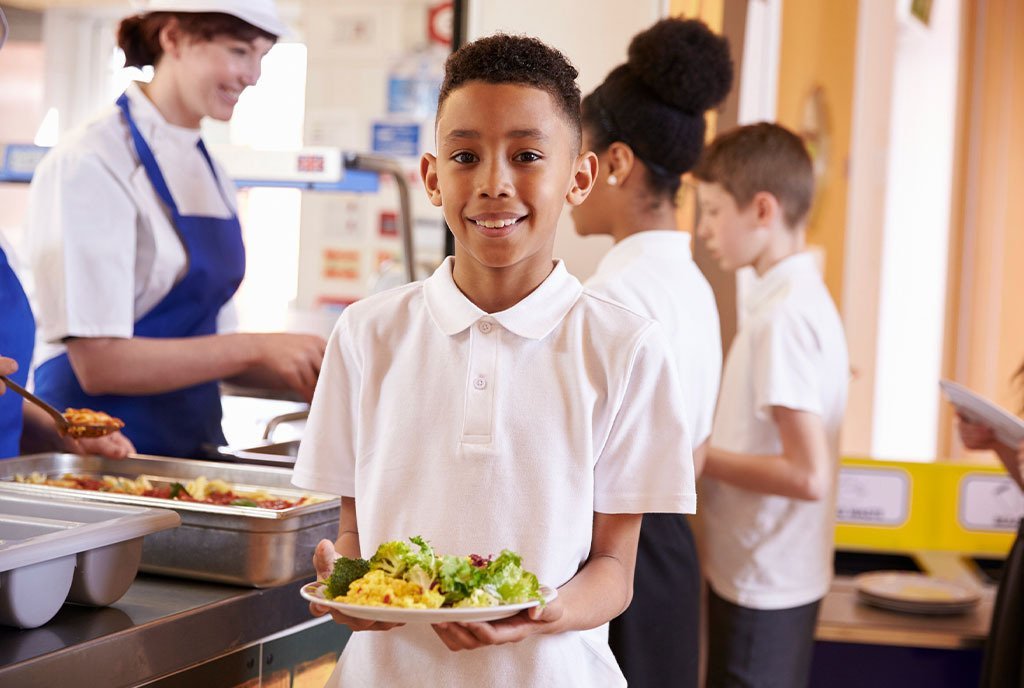
From dairy farmers in Wisconsin to ranchers in the Dakotas, small local producers face a myriad of challenges that could ultimately mean they literally lose their farms. But a unique approach to school lunches that uses local farms to produce food for children, regardless of their family’s financial situation, could hold the key to school lunch sustainability. .
Between rising prices, the rise of large-scale farming, and other social and family-related issues such as access to affordable child care, farmers are under pressure.
Climate change will only further exacerbate this balance, as weather becomes increasingly unpredictable and new pests emerge. Supply chain vulnerabilities have drawn national attention during the COVID-19 pandemic, when produce was left to rot as suppliers were unable to transport it to consumers and faced empty shelves. But it adds new concerns to an already troubled situation.
While farmers must contend with all of these factors, the lack of access to fresh, nutritious food is harming the public’s health. A growing body of research suggests that highly processed diets and poorly designed built environments are doing Americans more harm than good.
Poor food choices, poor environment, and expensive consequences.
Ultra-processed foods are associated with increased rates of cardiovascular disease, diabetes, depression, obesity, and cancer. However, it is difficult to pinpoint exactly why this increase is occurring. There is no consensus within the research community as to whether a single ingredient is responsible for these increases or whether a combination of ingredients is causing people to get sick. Sugar, for example, has been given special treatment by scientists and food policy. Excess trans fat intake is associated with heart disease and other cardiovascular problems.
Unfortunately, the complex relationship between food and health makes regulating highly processed foods surprisingly difficult.
Additionally, the packaging of ultra-processed foods has been found to be increasingly harmful to health. For example, bisphenol A, an industrial chemical used in the plastic packaging of some ultra-processed foods, is banned in some countries because it is associated with an increased risk of cardiometabolic disease. A similar chemical, bisphenol S, was introduced as a replacement. According to the National Institute of Environmental Health Sciences, bisphenol S is an endocrine disruptor, meaning it can interfere with hormones in the body and has been linked to several serious health problems.
Surprisingly, vulnerable young people are the first and often the most affected.
Processed foods in school lunches pose an additional barrier to optimal health and nutrition for U.S. school children. Although school lunches must follow specific dietary guidelines, school lunch nutrition standards do not explicitly prohibit ultra-processed foods. Regular consumption of processed foods, which are included in many school lunches across the country, is associated with malnutrition, affecting millions of children in the United States.
When it comes to protecting our health, the answer may seem to lie in eating less ultra-processed foods, but the reality is more complex. Many people do not have access to healthy foods due to cost, access, or both.
In some places, food deserts are also more commonly concrete deserts without healthy food or nature. This lack of green space is also associated with negative health outcomes, including poor mental health. Many studies have also shown that reduced exposure to the natural environment increases the risk of premature death and reduces overall quality of life.
At the most basic level, not having access to healthy foods and nature can have an incredibly negative impact on your overall health and well-being. Surprisingly, vulnerable young people are the first and often the most affected.
The importance of universal school lunches
The bigger problem for many children is if they can eat healthy food but if they are going to eat. Approximately 43 million Americans face food insecurity across the country. This means that one in 10 people in the world’s richest country go hungry, including around 11 million children.
Evidence about child hunger in the United States dates back at least to a study published in 1905 that revealed food insecurity was a widespread problem. This recognition, combined with the advocacy of women’s rights organizations at the time, led to the emergence of the first free or reduced-price lunch programs in cities such as Boston and New York. These programs had such a positive impact on children that the federal government created its own program during the Great Depression.
Sign up for our free newsletter
apply NPQ’s Get our top stories delivered straight to your inbox with our newsletter.
By signing up, you agree to our Privacy Policy and Terms of Use and agree to receive messages from NPQ and our partners.
The bigger problem for many children is if they can eat healthy food but if they are going to eat.
Similarly, the Universal School Lunch Program has become very popular during the COVID-19 pandemic, when pandemic relief programs eliminated much of the paperwork previously required to take advantage of breakfast and lunch programs. It has proven to be valuable. The expansion of school lunch programs benefited households across income brackets. And, as researchers at the Urban Institute point out, the benefits extend beyond health and nutrition. [and] Prejudice is reduced. ”
But even as inflation continues to rise and many families’ access to healthy food is further restricted, the federal government has reduced universal access to school lunch programs. Currently, 93.6 percent of school districts are reporting increased debt from families who are not eligible for grants or who did not know they should apply for grants. These debts have consequences. Families’ school lunch debts can be collected, and school officials publicly shame students who cannot afford school lunches. For example, in 2016, an Alabama elementary school teacher stamped an 8-year-old’s hand with the words, “I need money for lunch.” Or children may simply be hungry.
Community advocates and nonprofits are pushing for state-led responses to child hunger, like Hunger Day in Minnesota, hosted by Hunger Solutions to pressure legislators to address hunger in their communities. I’ve been fighting for it. This effort came to fruition when Minnesota Governor Tim Walz signed a bill allocating state funds to provide free universal lunch and breakfast to all students in the state. Minnesota isn’t the only state using universal school lunches to improve overall health. Other states have passed similar legislation, including California, Colorado, and Maine, and 24 more states are considering legislation. But while Minnesota’s school lunch program has proven to be extremely popular, it’s also proven to be more expensive than expected.
School gardens, combined with school lunch programs where children eat food they grow themselves, have a positive impact on the environment.
Supporting universal school lunch programs using schoolyards
While increasing federal support for universal school lunch programs is perhaps the most obvious solution, new and innovative ways to fund programs could address multiple concerns simultaneously. One way is to expand or reintroduce school garden programs that are eligible for USDA grants.
The introduction of a school garden has a significant impact on the students who have access to it. Gardeners, an organization that supports schoolyard and farm programs for Chicago schoolchildren, has seen an increase in students’ healthy eating and improved social and emotional skills. Additionally, school gardens have been shown to improve children’s eating behaviors by increasing children’s dietary self-efficacy, nutritional knowledge, vegetable preference, and vegetable intake.
School gardens, combined with school lunch programs where children eat food they grow themselves, have a positive impact on the environment. By separating school lunches from multinational corporations, local communities can reduce the environmental costs of transporting and packaging food. Of course, school gardens alone won’t be enough to fully feed every student, but it’s a good place to start.
buy food from local farmers
Another approach that can easily be combined with a school garden is to source food directly from local farmers.in Barron’s: Money, Power, and Corruption in America’s Food Industry, Austin Frelick points out how reliable contracts offered by schools can be a lifeline for small, local producers hurt by monopolistic markets for their products. Even farmers in more specialized markets, like bison farmers Kurt and Chris Wensel of Colfax, Wisconsin, think it would be great to sell to the local community, including the local school district. That’s important.”
Although Wisconsin is not a state with universal school lunches, it is ahead of the curve in connecting farmers and schools through farm-to-school programs. The Tides Foundation also offers programs that connect farmers and schools. Meanwhile, the USDA offers a variety of grants for both school gardens and farm-to-school programs.
Despite their promise for both human health and climate change mitigation, these efforts have been slow to take off. The industrial food system, including packaging and global food transportation, contributes significantly to climate change. According to a report by the Global Alliance for the Future of Food, the majority of fossil fuel consumption in our food system comes not from food production but from “processing and packaging stages (42%), and retail consumption and waste.” (38%). ”
The introduction of universal school meals and farm-to-school programs creates opportunities for children, farmers, and their broader communities to build healthier, more sustainable places. By using locally grown and cultivated food, both in school gardens and on local farms, schools can also improve nutrition and improve the health and well-being of schoolchildren across the United States. In the midst of current challenges posed by the climate crisis, food insecurity, and malnutrition, these investments in America’s children and local food systems will help ensure health, wellness, and prosperity are more equitably distributed. It could lead America down a new path.

